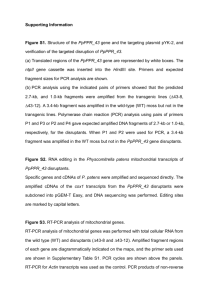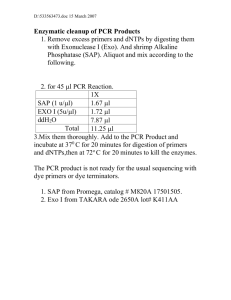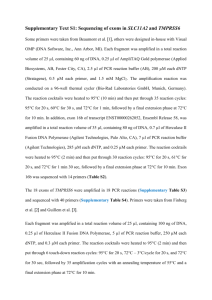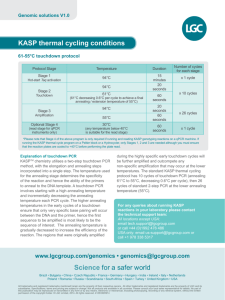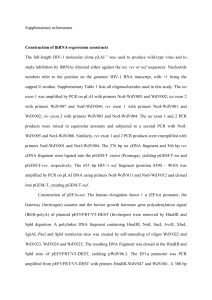Mapping of ESTs by radiation hybrid panel.
advertisement
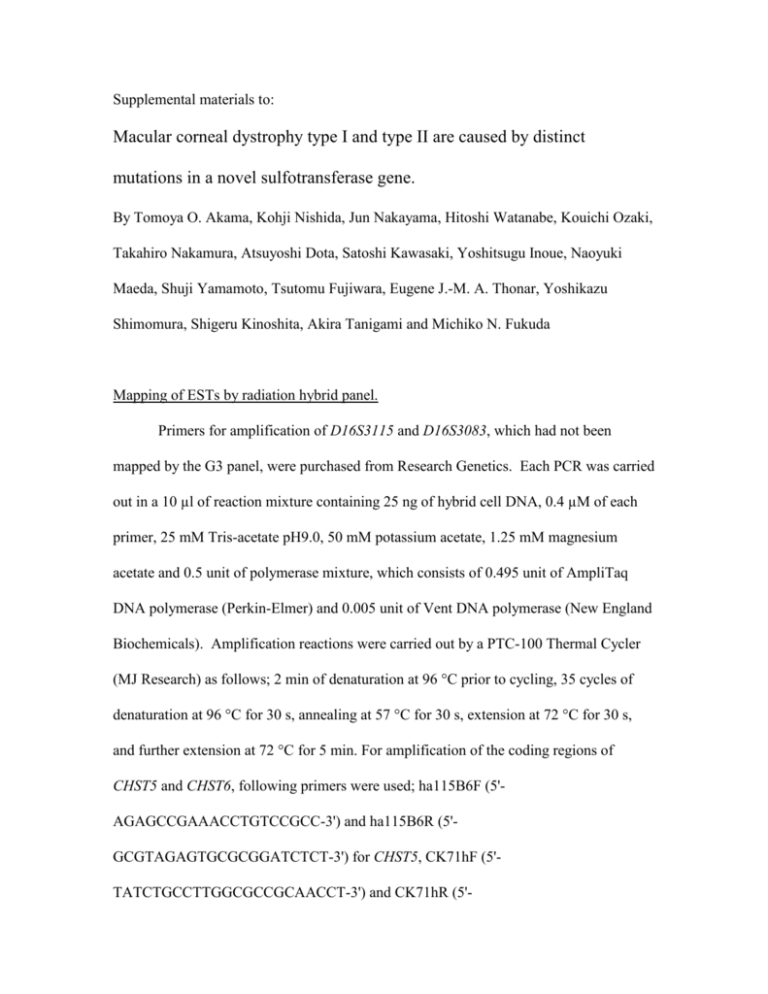
Supplemental materials to: Macular corneal dystrophy type I and type II are caused by distinct mutations in a novel sulfotransferase gene. By Tomoya O. Akama, Kohji Nishida, Jun Nakayama, Hitoshi Watanabe, Kouichi Ozaki, Takahiro Nakamura, Atsuyoshi Dota, Satoshi Kawasaki, Yoshitsugu Inoue, Naoyuki Maeda, Shuji Yamamoto, Tsutomu Fujiwara, Eugene J.-M. A. Thonar, Yoshikazu Shimomura, Shigeru Kinoshita, Akira Tanigami and Michiko N. Fukuda Mapping of ESTs by radiation hybrid panel. Primers for amplification of D16S3115 and D16S3083, which had not been mapped by the G3 panel, were purchased from Research Genetics. Each PCR was carried out in a 10 µl of reaction mixture containing 25 ng of hybrid cell DNA, 0.4 µM of each primer, 25 mM Tris-acetate pH9.0, 50 mM potassium acetate, 1.25 mM magnesium acetate and 0.5 unit of polymerase mixture, which consists of 0.495 unit of AmpliTaq DNA polymerase (Perkin-Elmer) and 0.005 unit of Vent DNA polymerase (New England Biochemicals). Amplification reactions were carried out by a PTC-100 Thermal Cycler (MJ Research) as follows; 2 min of denaturation at 96 °C prior to cycling, 35 cycles of denaturation at 96 °C for 30 s, annealing at 57 °C for 30 s, extension at 72 °C for 30 s, and further extension at 72 °C for 5 min. For amplification of the coding regions of CHST5 and CHST6, following primers were used; ha115B6F (5'AGAGCCGAAACCTGTCCGCC-3') and ha115B6R (5'GCGTAGAGTGCGCGGATCTCT-3') for CHST5, CK71hF (5'TATCTGCCTTGGCGCCGCAACCT-3') and CK71hR (5'- CCGTTGTCACGCGCCAGAGCCTT-3') for CHST6. PCR conditions were same as described above, except 62 °C was used for annealing in the case of CHST5 and 65 °C for annealing in the case of CHST6. Isolation of full-length cDNA and genomic clones of CHST6 Human whole brain Marathon-ready cDNA (Clontech) was used for 5'- and 3'RACEs. Amplifications of the 5'- and 3'-regions were carried out according to the methods recommended by the manufacturer. Following oligomers were used as CHST6 specific primers for PCR; CK71hR for the first 5'-RACE, CK71h2R (5'CGGGGAAAGGCACTGCAGGCGG-3') for the second 5'-RACE, CK71hF for the first 3'-RACE, CK71h2F (5'-CGACCCCGCGCTCAACCTACGCA-3') for the second 3'RACE. In situ hybridization. CHST6 specific region was amplified by PCR using CK71h-F1858 (5'CACGAGGCCTGAACGGCTTCAC-3') and CK71h-R1949 (5'CGGGCCTAGCGCCTGCTACAAC-3'). This amplicon was cloned into SmaI site of pGEM3Zf(+) (Promega) and used to prepare RNA probes by DIG RNA Labeling Kit (Boehringer Mannheim). Analysis of mutations in CHST6. Genomic DNAs from MCD patients and normal individuals were amplified by PCR as follows. The coding region of CHST6 was amplified by PCR using the following primers; for the 5'-coding region, CK71h-intrn (5'-GCCCCTAACCGCTGCGCTCTC-3') and CK71h-R1180 (5'-GGCTTGCACACGGCCTCGCT-3'); for the middle coding region, CK71h-F1041 (5'-GACGTGTTTGATGCCTATCTGCCTTG-3') and CK71hR1674 (5'-CGGCGCGCACCAGGTCCA-3'); for the 3'-coding region, CK71h-F1355 (5'CTCCCGGGAGCAGACAGCCAA-3') and CK71h-R1953 (5'CTCCCGGGCCTAGCGCCT-3'). Each PCR reaction was carried out in 25 µl as described above except for the annealing temperatures (55 °C for the middle coding region and 57 °C for the 5'- and 3'-coding regions) and the extension time (45 s). Amplified fragments were separated by electrophoresis in a 2% agarose gel, purified by QIAquick Gel Extraction Kit (Qiagen) and sequenced. Replacement and deletion mutations found in the upstream of CHST6 were detected by PCR as described above using following primers; F1 (5'-CCACAGAAGGAAGGACAGAGTAAATGAA-3'), F2 (5'-CATATCCTGTCTGGCCTAAACCTTAGTTTAC-3'), R1 (5'TTCCCTTTACTATTATAAAAATGCTGCTAATG-3'), R2 (5'GGGCACAGACAGAGGGAAAAACC-3'), F2M (5'GGCCAAGTTCAGGTCAGCTTCCA-3'), R1M (5'TGCTGAATGGCTAACTGAAGGAATACTATAC-3'). For these PCRs, the same reaction cycles were used as described above except for the annealing temperature (55 °C). PCR-RFLP analysis. The region flanking each missense mutation was amplified by PCR using following primers; for C1301A, RFLP1 (5'-TGCTCTACCCGCTGCTCAGCGAC-3') and RFLP2 (5'-CGGGAGCGCAGCACGGCCCCCGG-3'); for C840A, CK71h-F781 (5'AGACCTTCCTCCTCCTCTTTCTGGTT-3') and RFLP3 (5'TTGGCCCACGAAGGACGAGCCCGGGC-3'). After digestion with SmaI for C1301A and KasI for C840A, amplified DNA fragments were separated on 15% polyacrylamide gels for 2 h. The gel was stained by ethidium bromide and analyzed on an UV transilluminator. Southern blot analysis. DNA fragments used as a probe were prepared by PCR using the same condition described above and primers A3L114 (5'-TGCCCCCAGAAAAGAATCAAA-3') and BamL142 (5'-TCCTCCCAAGTCCCTTGGAG-3'). Amplified fragment was purified by QIAquick Gel Extraction Kit (Qiagen) and labeled with -32P-dCTP using Prime-It RmT kit (Stratagene). The blotted filter was hybridized with the probe in ExpressHyb hybridization solution (Clontech) according to the methods recommended by the manufacturer. After washing with 1x SSC-0.1% SDS at 50 °C for 1 h, the filter was exposed to X-ray film with an intensifying screen at -80 °C for 5 days.


